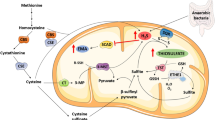Abstract
Ethylmalonic encephalopathy (EE) is a rare autosomal recessive disorder characterized by early onset encephalopathy, chronic diarrhoea, petechiae, orthostatic acrocyanosis and defective cytochrome c oxidase (COX) in muscle and brain. High levels of lactic, ethylmalonic and methylsuccinic acids are detected in body fluids. EE is caused by mutations in ETHE1, a mitochondrial sulphur dioxygenase. By studying a suitable mouse model, we found that loss of ETHE1 leads to accumulation of sulphide, which is a poison for COX and other enzymatic activities thus accounting for the main features of EE. We report here the first autopsy case of a child with a genetically confirmed diagnosis of EE, and compare the histological, histochemical and immunohistochemical findings with those of the constitutive Ethe1 −/− mice. In addition to COX depleted cells, widespread endothelial lesions of arterioles and capillaries of the brain and gastrointestinal tract were the pathologic hallmarks in both organisms. Our findings of diffuse vascular damage of target critical organs are in keeping with the hypothesis that the pathologic effects of ETHE1 deficiency may stem from high levels of circulating hydrogen sulphide rather than the inability of specific organs to detoxify its endogenous production.





Similar content being viewed by others
References
Barth M, Ottolenghi C, Hubert L et al. (2010) Multiple sources of metabolic disturbance in ETHE1-related ethylmalonic encephalopathy. J Inherit Metab Dis Oct 27. [Epub ahead of print]
Burlina A, Zacchello F, Dionisi-Vici C et al. (1991) New clinical phenotype of branched-chain acyl-CoA oxidation defect. Lancet 338:1522–1523
Cavanagh JB, Harding BN (1994) Pathogenic factors underlying the lesions in Leigh's disease. Tissue responses to cellular energy deprivation and their clinico-pathological consequences. Brain 117:1357–1376
Di Meo I, Fagiolari G, Prelle A, Viscomi C, Zeviani M, Tiranti V (2011) Chronic exposure to sulphide causes accelerated degradation of cytochrome c oxidase in ethylmalonic encephalopathy. Antioxid Redox Signal 5(2):353–362
Dorman DC, Moulin FJ, McManus BE, Mahle KC, James RA, Struve MF (2002) Cytochrome oxidase inhibition induced by acute hydrogen sulphide inhalation: correlation with tissue sulphide concentrations in the rat brain, liver, lung, and nasal epithelium. Toxicol Sci 65(1):18–25
Garavaglia B, Colamaria V, Carrara F, Tonin P, Rimoldi M, Uziel G (1994) Muscle cytochrome c oxidase deficiency in two Italian patients with ethylmalonic aciduria and peculiar clinical phenotype. J Inherit Metab Dis 17(3):301–303
Garcia-Silva MT, Campos Y, Ribes A et al. (1994) Encephalopathy, petechiae, and acrocyanosis with ethylmaloni aciduria associated with muscle cytochrome c oxidase deficiency. J Pediatr 125:843–844
Grosso S, Mostardini R, Farnetani MA et al. (2002) Ethylmalonic encephalopathy: further clinical and neuroradiological characterization. J Neurol 249(10):1446–1450
Jamroz E, Paprocka J, Adamek D et al. (2011) Clinical and neuropathological picture of ethylmalonic aciduria - diagnostic dilemma. Folia Neuropathol 49(1):71–77
Szabo C (2007) Hydrogen sulphide and its therapeutic potential. Nat Rev Drug Discov 6(11):917–935
Tiranti V, D’Adamo P, Briem E et al. (2004) Ethylmalonic encephalopathy is caused by mutations in ETHE1, a gene encoding a mitochondrial matrix protein. Am J Hum Genet 74(2):239–252
Tiranti V, Briem E, Lamantea E et al. (2006) ETHE1 mutations are specific to ethylmalonic encephalopathy. J Med Genet 43(4):340–346
Tiranti V, Viscomi C, Hildebrandt T et al. (2009) Loss of ETHE1, a mitochondrial dioxygenase, causes fatal sulphide toxicity in ethylmalonic encephalopathy. Nat Med 15(2):200–205
Viscomi C, Burlina AB, Dweikat I et al. (2010) Combined treatment with oral metronidazole and N-acetylcysteine is effective in ethylmalonic encephalopathy. Nat Med 16(8):869–871
Wang R (2011) Signaling pathways for the vascular effects of hydrogen sulphide. Curr Opin Nephrol Hypert 20(2):107–112
Yang G, Cao K, Wu L, Wang R (2004) Cystathionine γ-lyase overexpression inhibits cell proliferation via H2S-dependent modulation of ERK1/2 phosphorylation and p21CIp-WAC-1. J Biol Chem 279(47):49199–49205
Yang G, Wu L, Wang R (2006) Pro-apoptotic effect of endogenous H2S on human aorta smooth muscle cells. FASEB J 20(3):553–555
Acknowledgements
This work was supported by Telethon Grants GGP07019 and GPP10005 to MZ; AFM grant 2010/14458 to MZ, Fondazione Pierfranco e Luisa Mariani (MZ), Associazione Serena Talarico per i Giovani nel Mondo (GdA) and Fondazione Giuseppe Tomasello ONLUS (MZ and GdA).
Author information
Authors and Affiliations
Corresponding authors
Additional information
Communicated by: Shamima Rahman
Competing interests: None declared.
Rights and permissions
About this article
Cite this article
Giordano, C., Viscomi, C., Orlandi, M. et al. Morphologic evidence of diffuse vascular damage in human and in the experimental model of ethylmalonic encephalopathy. J Inherit Metab Dis 35, 451–458 (2012). https://doi.org/10.1007/s10545-011-9408-3
Received:
Revised:
Accepted:
Published:
Issue Date:
DOI: https://doi.org/10.1007/s10545-011-9408-3




